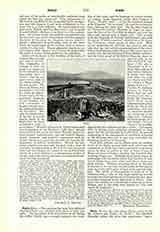

Nails, Holy. The question has long been debated whether Christ was crucified with three or with four nails. The treatment of the Crucifixion in art during the earlier Middle Ages strongly supports the tradition of four nails, and the language of certain historical writers (none, however, earlier than Gregory of Tours, “De glor. mart.”, vi; for the supposed sermon of St. Cyprian, “De passione”, is a medieval fabrication), favors the same view. On the other hand, in the thirteenth century, Western art began to represent the feet of the Crucified as placed one over the other and pierced with a single nail. This accords with the language of Nonnus and Socrates and with the poem “Christus patiens” attributed to St. Gregory Nazianzus, which speaks of three nails. More recent archaeological criticism has pointed out not only that the two earliest representations of the crucifixion (the Palatine graffito does not here come into account), viz., the carved door of Santa Sabina in Rome, and the ivory panel of the British Museum, show no signs of nails in the feet, but that St. Ambrose (“De obitu Theodosii” in P.L., XVI, 1402) and other early writers distinctly imply that there were only two nails (see Forrer and Muller, “Kreuz u. Kreuzigung Christi”). Further, St. Ambrose informs us that St. Helen had one nail converted into a bridle for Constantine’s horse (early commentators quote Zach., xiv, 20, in this connection), and that an imperial diadem was made out of the other nail. Gregory of Tours speaks of a nail being thrown (deponi), or possibly dipped into the Adriatic to calm a storm. It is impossible to discuss these problems adequately in brief space, but the information derivable from the general archaeology of the punishment of crucifixion as known to the Romans does not in any way contradict the Christian tradition of four nails.
Very little reliance can be placed upon the authenticity of the thirty or more holy nails which are still venerated, or which have been venerated until recent times, in such treasuries as that of Santa Croce in Rome, or those of Venice, Aachen, the Escurial, Nuremberg, Prague, etc. Probably the majority began by professing to be facsimiles which had touched or contained filings from some other nail whose claim was more ancient. Without conscious fraud on the part of anyone, it is very easy for imitations in this way to come in a very brief space of time to be reputed originals. The bridle of Constantine is believed to be identical with a relic of this form which for several centuries has been preserved at Carpentras, but there is another claimant of the same kind at Milan. Similarly the diadem of Constantine is asserted to be at Monza, and it has long been known as “the iron crown of Lombardy“.
HERBERT THURSTON

